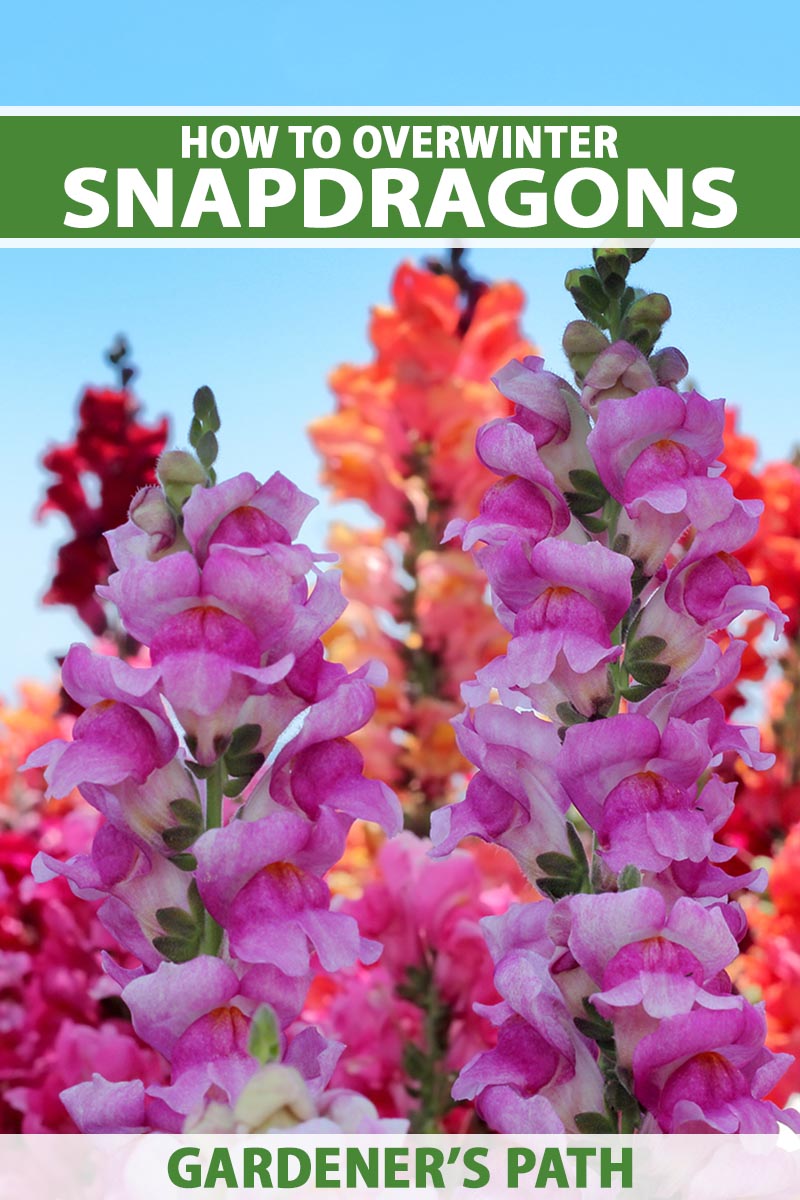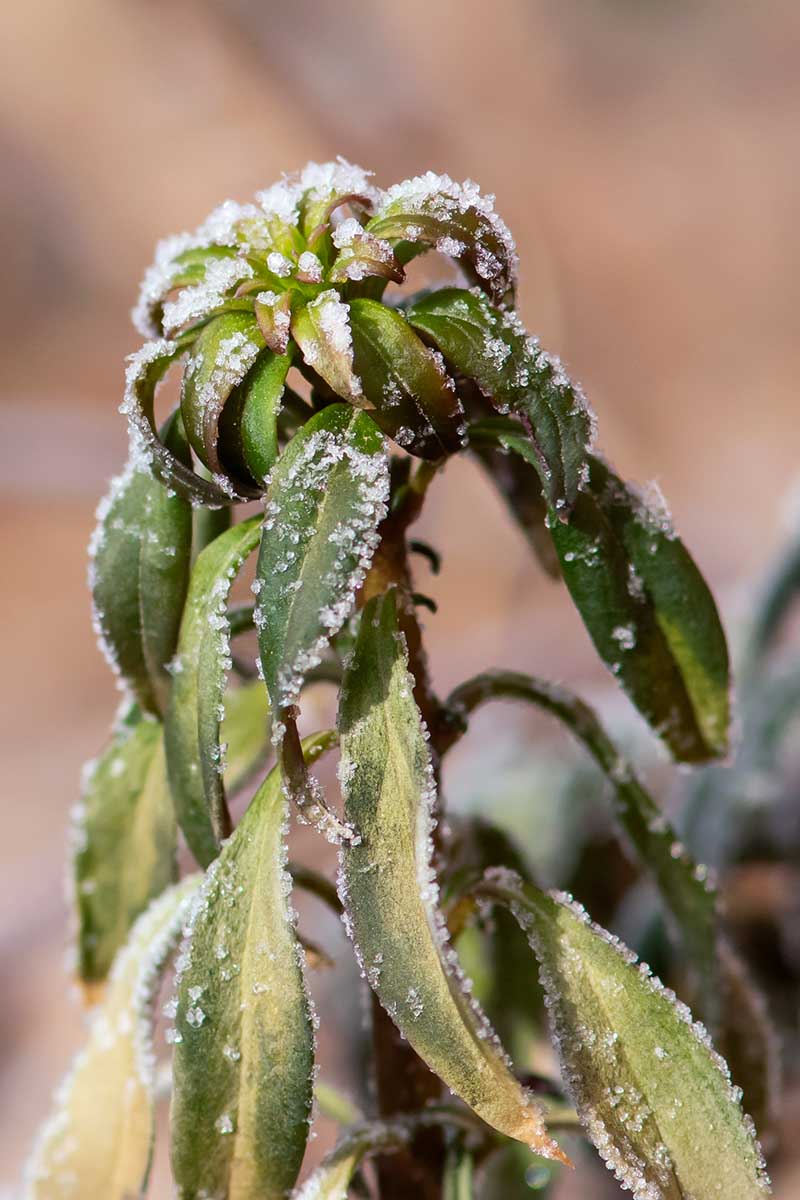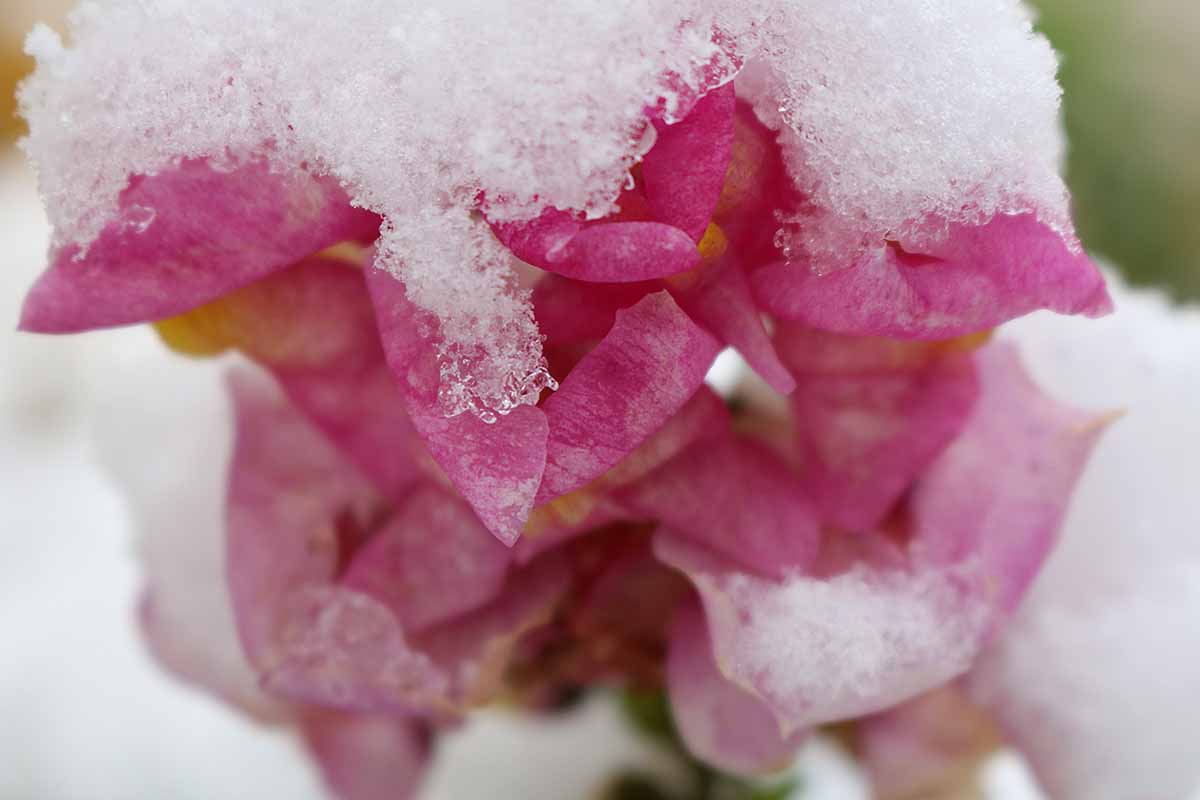Snapdragons are one of those varieties of plants that are a staple in summer gardens.
Home stores, grocery stores, and nurseries sell them by the flat during the summer for gardeners to add some annual color to their beds.

We link to vendors to help you find relevant products. If you buy from one of our links, we may earn a commission.
But snapdragons aren’t actually annuals. They’re short-lived perennials that are sensitive to frost. And that means they can stick around year after year if you’re willing to give them a bit of protection.
We have a guide available If you want to learn more about the life cycle of snapdragons.
If you’re interested in keeping these beauties around to bloom again next year, even if you don’t live in USDA Hardiness Zones 7 and above, stick around.
In this guide, we’ll discuss overwintering these cottage garden classics. We’re going to go over the following:
What You’ll Learn
Whether you plant them in containers or grow them in the ground, it’s possible to keep your snapdragons around through the winter months.
What Temperatures Do Snapdragons Thrive In?
Ideally, Antirrhinum species grow in conditions around 50°F at night and anywhere from 60 to 75°F during the day. But they’re flexible and temperatures down into the 40s and up into the 90s won’t hurt them.
It’s when things become much colder that you run into trouble. A brief period under -15°F is a sure death sentence for these plants.

Gardeners in regions down to Zone 6 can overwinter their plants outdoors with just a little bit of extra protection. Those in colder regions are going to need to provide some serious protection if they want these short-lived perennials to return in the spring.
Another option is to simply let your plants go to seed. Snapdragons self-seed freely, and this is another excellent way to keep your cottage garden patch going. We’ll talk about that shortly.
Here are your various options:
Overwintering in a Garage or Basement
Container snapdragons are the easiest to overwinter because you can simply move them somewhere toasty.
If your plants are in the ground but you live in Zone 5 or below, you might want to dig them up and put them in a container so you can move them.
Just before the first frost arrives, bring the plants into a garage or basement. You don’t want the spot you select to be too warm or it will stimulate growth when plants should be dormant. But it should be protected from sub-zero temperatures.
Trim off any remaining flower stalks and place pots in a sheltered spot away from any windows. They should receive indirect light, but no direct sunlight. If your garage or basement doesn’t have any windows, this might not be the best option.
Water the containers when the top two inches of the soil dry out. You want to avoid overwatering because these plants use much less water in the winter than they do in the summer.
Harden the containers off in the spring after the last predicted frost date.
Keep them inside on any days that drop below 35°F. Hardening off involves taking the plants outside and placing them in a protected area for an hour and then bringing them back inside to begin.
On day two, add an hour. Add another hour on day three. After a week of adding an hour of sun and outdoor exposure each day, your plant is ready to be placed in its permanent spot.
Providing Winter Protection in Tunnels
Snapdragons grown in the ground or containers are a snap to overwinter in tunnels. High tunnels are a little more challenging to work with than low tunnels, but both are possible options.
Growers that provide some supplemental lighting can even grow snapdragons that flower continuously all year long.
Low tunnels provide 10 to 20 degrees of extra warmth during the winter plus protection from frost, so they provide a good amount of protection overall.

High tunnels provide about 10 degrees of extra warmth but they won’t prevent frost from coating your plants. Best to stick to high tunnels in warmer climates like Zone 7 and above.
Tunnels should be erected over plants before the first hard freeze and removed after the last predicted frost date.
You might have to toss frost blankets over them if an extended freeze arrives, but one night of frost won’t hurt the plants.
Let Mother Nature provide the moisture unless you have a really dry winter. If the top two inches of the soil dry out, provide some supplemental water.
Mulch
If you’re growing in the ground and you live in Zones 6 and up, heaping some mulch over the root zone can keep your plant alive, though the aboveground parts will die back.
Use something like leaf mulch, straw, grass clippings, or cardboard and heap at least two or three inches of mulch over the soil so it’s covering the entire root zone and the crown and extend it several inches beyond that. In the spring, spread it out.
Self-Seeding
If you opt to let your plant self-seed rather than overwintering the mature plants, the process is fairly simple.
In the fall as the pollinated flowers mature, they’ll develop dry, brown seed pods. Let them open and drop the seeds to the ground, or gently pluck them off and rub them between your hands.
Gently drop the seeds on the ground to sow them wherever you wish to have more flowers the following season.

Spread an inch-thick layer of soil, mulch, or compost over the ground where you placed the seeds.
Just be aware that germination can be irregular, so you might not have a formal, uniform, dense look in the year to follow. Some seeds might lie dormant for years before germination and others might never germinate.
Plus, you never know what the plants will look like if they’ve been cross-pollinated. You can’t guarantee that they’ll be identical to the parent plant.
There are also some hybrids that produce sterile seeds, like the Madame Butterfly series, so you won’t be able to use this method successfully if that’s what you’re growing.
Bring Back Snapdragons Year After Year
I’m always looking for ways to save cash and resources.
When we dig up and toss out “annual” flowers when we don’t need to, we’re throwing out money and wasting water, fertilizer, and the resources it takes to transport flowers from the nursery to the store to your house.
By overwintering your snapdragons, you can keep them around longer than you’d be able to otherwise.

Extra bonus: plants that stick around year after year grow larger than new snapdragons planted fresh each year!
Which method are you planning to use this winter? Share with us in the comments!
If you can’t wait to learn more about fabulous snapdragons, we have a few other guides you should consider checking out next:



I’m gonna try it! I live in Michigan and we just had our first frost last night. My plants are inside and I’m working on getting them in the basement with some indirect sunlight. Thank you!
Just noticed all the snapdragons all nice and bushy. So, I am going to mulch w/leave mulch and will report experience in the spring. Thanks for this information
Thanks for reading! Let us know how it works out for you. Happy gardening!